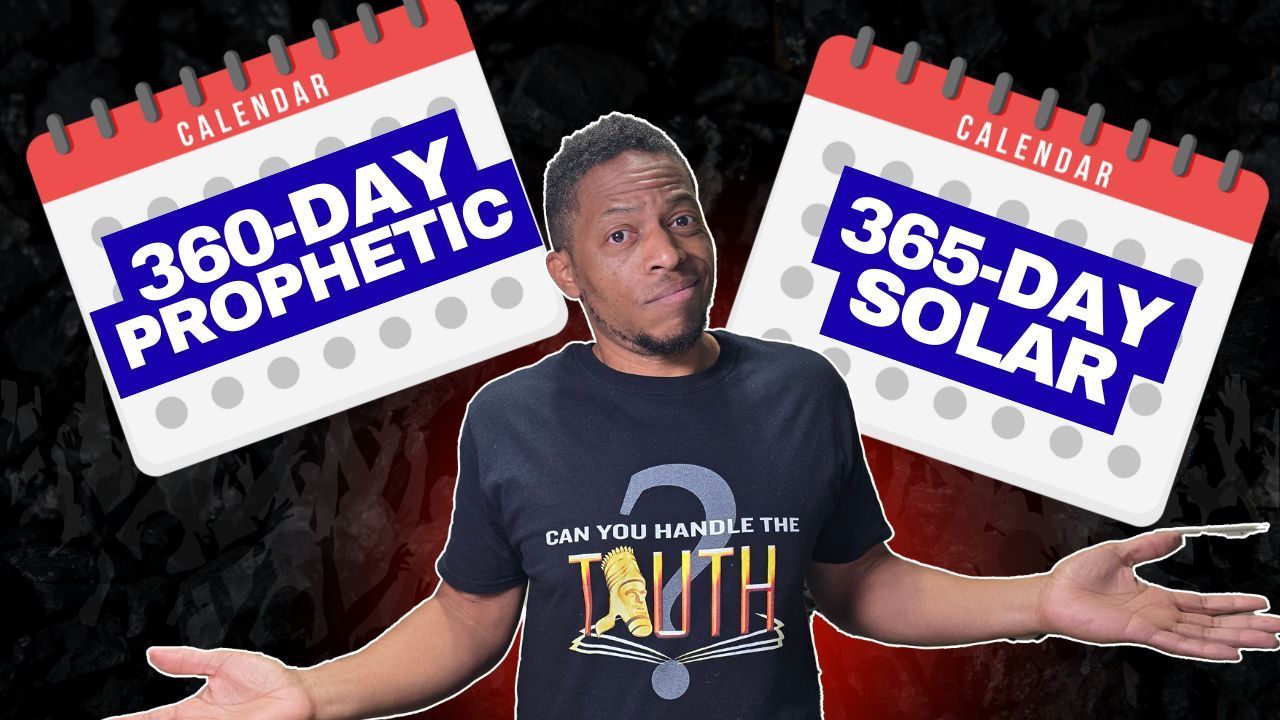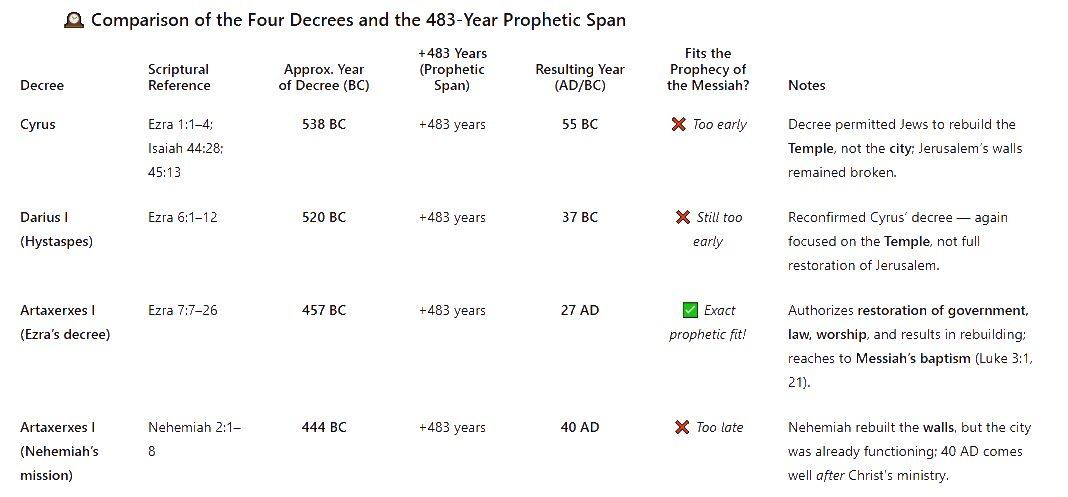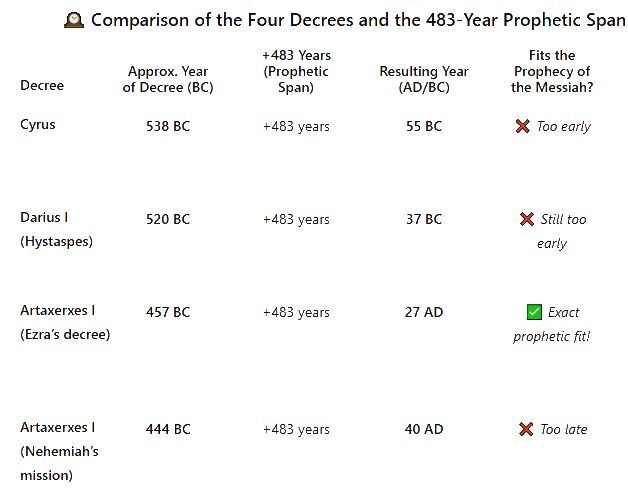
For centuries, students of prophecy have wrestled with a crucial question: How does the Bible calculate prophetic time prophecy? Some argue for the standard solar year of 365 days, while others strongly insist that prophecy must be calculated using a 360-day year—a so-called “a prophetic year.”
This disagreement affects major prophetic timelines, including the 70 weeks of Daniel 9, the 1260 years, and the 2300 evenings and mornings. Choosing one method over the other can shift prophetic fulfillments by decades.
Today we’re going to settle this question from Scripture—not from human logic—and determine exactly when the Bible uses a 360-day year, when it does not, and why this distinction matters. Let’s study!
Why the Debate Matters
If you replace the standard solar year (365.24 days) with a 360-day “prophetic” year when calculating long chronologies, the results change dramatically.
For example: Using real historical years, the Adventist interpretation of the 2300 years ends in 1844. However, using a 360-day year for the same 2300-year span, the prophecy ends around 1810. As you can see, the difference of 34 years would change the landscape of, not only the Investigative Judgment, but it would radically alter Adventist the theology of Adventist prophecy as a whole! So understanding how God expects us to count prophetic time is not optional—it is foundational.
Why Some Scholars Use a 360-Day Prophetic Year
Supporters of the 360-day year often point to two types of biblical evidence:
A. The 360-day year in Noah’s time
Genesis describes the flood lasting 150 days across 5 months (Genesis 7:11, 7:24, 8:4).
Calculating the 150 days with the 5-month period reveals that each month was likely to be 30 days each, which further computes the 12 months of the year as a 360-day year. Thus, there is strong evidence that in Noah’s day, the Earth appears to have operated on a 360-day cycle around the sun.
B. The 360-day unit in Daniel and Revelation
Prophecies such as:
- “time, times, and half a time”
- 42 months
- 1260 days
all correspond perfectly when you use 30-day months and a 360-day year.
Please understand, Adventist prophetic reckoning does confirm and utilize the Biblical 360-day principle found in a number of prophetic contexts; however, the existence of a 360-day prophetic unit does not automatically mean that every prophecy should be reckoned by a 360-day year. To know how God wants us to apply prophetic time, we must look at how God Himself applied it in actual events.
Prophetic time unit vs. prophetic time reckoning
Please understand that there is a
difference between how prophetic time is classified and how prophetic time is utilized. The reason why this is important is due
Example:
- 1 year = 360 days
- 1 month = 30 days
- 1 day = 24 hours
- 1 hour = 60 minutes
These units create a clean, standardized system so prophecy can be calculated without astronomical confusion (leap days, leap seconds, elliptical orbits, etc.).
B. Prophetic Time Application (actual passing of real-world time)
This refers to how long the prophecy lasts in real life:
- A “year” is a spring-to-spring cycle.
- A “month” is a new moon to new moon cycle.
- A “day” is evening to evening.
The application uses real solar seasons, not the 360-day idealized model.
Now the question becomes:
Which system does God use when a prophecy spans many years—like the 70 weeks (490 years) or the 2300 years?
To answer that, we must look at a prophecy where Scripture itself records the beginning, the end, and confirms how God applied the time.
There is only one such example.
4. The 40 Years in the Wilderness: God Shows Us How to Count
The “day-for-a-year” principle is first spelled out in:
- Numbers 14:34 – “Each day for a year…”
But the wilderness wandering also provides timestamps:
- When it started
- How long it lasted
- When it ended
- The ages of Moses and Aaron before and after
And all these timestamps fit together only if God used real solar years, not 360-day cycles.
Let’s walk through it.
A. When did the 40 years begin?
Deuteronomy 16:1 tells us the Exodus occurred in the month of Abib, the 1st month of the Jewish year (roughly March/April).
So the 40 years began in:
Month 1, Year 1.
B. How old were Moses and Aaron at the Exodus?
Exodus 7:7:
- Moses: 80
- Aaron: 83
Add 40 years:
- Moses: 120
- Aaron: 123
Scripture confirms this precisely:
- Moses died at 120 (Deut. 34:7)
- Aaron died at 123 (Num. 33:38–39)
This only works if the 40 years were real solar years.
If the 40 years had been 360-day years, their ages would not align.
C. When did they die?
Aaron died:
- 5th month of the 40th year (Num. 33:38)
Moses died:
- 11th month of the 40th year (Deut. 1:3)
Here’s the key:
If these were 360-day years, the 5th and 11th months of the “40th year” would fall across different real-world years.
But Scripture says both deaths happened in the same year of the Exodus.
The timeline only holds if God uses the real Jewish year (spring to spring)—not a 360-day model.
D. What happened after Moses died?
Deut. 34:8 says Israel mourned Moses for 30 days, ending near the end of the 40th year.
Then:
Joshua 4:19 – They crossed the Jordan on the 10th day of the 1st month.
This places Moses’ death at the end of a real solar year—not the middle of a 360-day cycle.
Everything lines up perfectly with the common solar year.
5. What This Proves
The wilderness wandering is the only prophecy where God gives:
- a defined beginning
- a defined duration
- a defined ending
- real-world dates
- age markers to verify accuracy
And it unequivocally shows:
✔ God applies prophetic time using real, seasonal years—not 360-day years.
✔ The 360-day system is only a calculation unit, not a real-world calendar.
✔ Long prophecies (70 weeks, 2300 evenings-mornings) must use actual years.
Thus:
Using a 360-day year to defend the 444 BC decree in Daniel 9 simply does not match the biblical model of how God applies time.
6. So Why Does Daniel and Revelation Use 360-Day Units?
Because God needed a standardized calculation system.
Imagine trying to interpret:
- “time, times, and half a time”
- “1 hour, 1 day, 1 month, and 1 year” (Rev. 9:15)
using:
- variable lunar months
- seasons that drift
- leap days
- leap seconds
- elliptical orbits
It would be chaos.
The 360-day model normalizes the units so a prophetic period can be measured.
But the real-world fulfillment—like the 40 years—always follows real, observable, season-based time.
7. How This Applies to the 70 Weeks and the 2300 Years
When Gabriel says:
“From the going forth of the commandment… unto Messiah the Prince shall be 7 weeks and 62 weeks.”
—Daniel 9:25
That prophecy spans centuries.
And Scripture shows—by example—that long prophetic periods must be applied using:
actual years, not 360-day years.
This is why:
- 457 BC → AD 27 works perfectly
- 444 BC → AD 32 only works by forcing 360-day years
- The 2300 years end in 1844, not 1810
The Bible’s own model confirms this.
8. Final Conclusion
The Bible uses both time systems—just not in the way many assume.
360-day years are used as prophetic calculation units.
They standardize months and years so symbolic time can be measured.
Real-world fulfillments always occur in actual solar years.
The 40-year wilderness journey proves this beyond debate.
Therefore:
- The 444 BC decree does not meet the biblical criteria, even if forced into a 360-day framework.
- The Adventist foundation for the 70 weeks and 2300 years remains intact and consistent with Scripture.
- The Bible itself tells us how to calculate prophetic time—and it is not by replacing historical years with 360-day cycles.
When we examine the above decrees, we can clearly see that there's only one decree that is correctly timed. The 457 BC decree was issued 483 years before Christ's anointing by the Holy Spirit.
This should be an open and shut case, but many students of prophecy have realized that something pivotal is missing from Artaxerxes' first decree. Many have realized that there is no language that refers to the building of Jerusalem.
The Missing verbiage
When we read Ezra 7:11–26, we see strong references to restoration — the appointment of judges and magistrates, the reestablishment of civil order, and worship in the temple. All these represent restoration. However, there is no explicit command to rebuild the city itself. As a matter of fact, if you examine all four decrees, you will discover that none of them reference the rebuilding of Jerusalem.
If none of the decrees mention “rebuilding Jerusalem,” then why do we still identify Artaxerxes’ 457 BC decree as the one that fulfills Daniel’s prophecy? To answer that, we must look deeper at Gabriel's words to Daniel:
The Going forth of the command
Daniel 9:25 says:
“Know therefore and understand, that from the going forth of the commandment to restore and to build Jerusalem…”
That phrase “going forth” is critical. In Hebrew, it’s מוֹצָא (motsa), a noun meaning source, origin, or result. It is not the common verb יָצָא (yatsa), which Gabriel used when he said, "At the beginning of thy supplications the commandment came forth." Because Gabriel used motsa, we can conclude that Gabriel wasn't referring merely to the action of the decree being issued or even when the decree was issued, but rather when the command went into effect.
An example of this is Deuteronomy 8:3, which uses this same word when it says, “Man shall not live by bread alone, but by every word that proceedeth [motsa] out of the mouth of the Lord.” The focus is not just on God's Word, but the result that God's Word produces. So too, Daniel 9:25 points not necessarily to the date the decree was written, but to when it produced its result or went into effect.
Ellen G. White bluntly expresses this idea in the book, Christ in the Sanctuary (p. 84). Here's what she wrote:
“The decree of Artaxerxes went into effect in the autumn of 457 BC.”
However, according to Ezra 7:9, we know the decree was given in the spring that year:
“For upon the first day of the first month began he to go up from Babylon, and upon the first day of the fifth month came he to Jerusalem…”
The Jewish first month corresponds roughly to March or April, and the fifth month would be August or September. Therefore, the decree was issued in the spring, but went into effect in the fall, when Ezra arrived in Jerusalem and implemented it. That “going forth” — motsa— marked the real beginning of the prophecy.
Why the Decree Doesn’t Mention Rebuilding
If the decree doesn’t explicitly say “rebuild the city,” how could it still fulfill Daniel’s prophecy? The key is found in Ezra 4. Earlier in Artaxerxes’ reign, Israel’s enemies wrote a letter to him, warning that the Jews were “building the rebellious and evil city” (Ezra 4:12–13). Fearing insurrection, Artaxerxes issued a decree forbidding Jerusalem’s rebuilding when he responded, "Give ye now commandment to cause these men to cease, and that this city be not builded, until another commandment shall be given from me." (Ezra 4:21).
It's important to realize that Artaxerxes wrote this decree before the 457 BC decree. Why? Because, according to the law of the Medes and Persians, once a king issued a decree, not even he could reverse it! (see Daniel 6:8, 15 and Esther 8).
Subsequently, Artaxerxes, showing favor towards Ezra and having seen through the false accusations hurled at his people, became impressed that the Children of Israel should continue building the city. However, there was one problem— Artaxerxes couldn't legally reverse his earlier decree. So what did he do? He issued a new decree — carefully worded — full of ambiguous phrases like:
Whatever seems good to you and your brethren to do… do it according to the will of your God. (Ezra 7:18)
And whatever else is required for the house of your God, which it falls to you to provide, you may provide it out of the king’s treasury. (Ezra 7:20)
Whatever Ezra the priest, the scribe of the Law of the God of heaven, requires of you, let it be done with all diligence. (Ezra 7:21)
Whatever is commanded by the God of heaven, let it be diligently done. (Ezra 7:23)
This allowed the Jews, under Ezra’s leadership, to interpret the command as granting full authority to restore and rebuild Jerusalem, while simultaneously giving the king legal cover should anyone accuse him of contradicting his own law.
Thus, after Ezra arrived in Jerusalem in the fall, then and only then could the decree go into effect.
the rebuilding in scripture
Ezra organized leadership, reformed worship, and motivated the people to rebuild the city. We know this because in Ezra 9:9, he acknowledges:
For we were bondmen; yet our God hath not forsaken us in our bondage, but hath extended mercy unto us in the sight of the kings of Persia, to give us a reviving, to set up the house of our God, and to repair the desolations thereof, and to give us a wall in Judah and in Jerusalem..”
Ezra’s mention of “repairing desolations” and “giving a wall” indicates the process of restoration and rebuilding — the very result (the motsa) Daniel had foretold.
Conclusion: A Decree of Restoration and Rebuilding
Though the word “build” never appears in Artaxerxes’ decree, its result was both restoration and rebuilding.
By the king’s order — and Ezra’s faithful leadership — Jerusalem’s civil government, worship, and physical city were restored.
The prophecy of Daniel 9:25 was not fulfilled by the words written on parchment alone, but by the divine result that went forth from that command — the motsa that changed history. And thus, the decree of Artaxerxes in 457 BC stands confirmed as the decree “to restore and build Jerusalem,” marking the starting point of the 2300-year prophecy.



